Low Carb Peanut Noodles
Testimony of the Day
“Maria, Today is my 50th birthday and I feel AMAZING and that’s thanks to you!! I have lost 15# I have incredible energy, I sleep through the night for the first time in years, and I’m no longer hungry all the time. I can’t say enough about you, your books amazing recipes, and all the support you offer. As you know I have tried so many plans and have been a chronic dieter since age 13. This all makes sense and its a life change that is so easy to do. Thank you again for all that you do to make people healthy. P.S I plan to celebrate my birthday today by taking a 50-mile bike ride, I just had knee surgery 4 weeks ago and healed so well. This too has to do with the way I feel. Thanks, Mary”
To get the results like Mary, click here to get started. A year from now you will thank yourself!
Plan Plan Plan is the key to success
One trick that works for our family is that Craig helps clean up after dinner, while I prepare dinner for the next night. I often fill my slow cookers with a main dish, side dish, and dessert (yes, I have 3 beloved slow cookers). Then in the morning, all I have to do is take the slow cooker shell out of the fridge and turn them on. That takes so much stress and anxiety out of my day!
To get over 300 slow cooker recipes, check out The Art of Healthy Eating: Slow Cooker, click HERE to order.
My favorite slow cooker today! Click HERE to find. And this one is more affordable and is $10 off today.
Happy Eating! Thank you all for your love and support!
Coconut Aminos
You may look at the ingredients and see “Coconut Aminos” or “Tamari” sauce and say “What?”!!! So what is it? and why ORGANIC? Monsanto Co., the world’s largest seed producer, has developed the first-generation Roundup Ready soybean (and corn) seeds…they are in discussion about putting Roundup INSIDE the seed so the weeds have no chance against the crop! Well, what ramifications does this have for our health? Do you notice a rise in auto-immune diseases? cancer? fatty livers? AHHH!!! We aren’t sure just how bad it can become, but some issues are precancerous cell growth in the digestive tract, inhibited the development of the brain, liver, and testicles, partial atrophy of the liver, enlarged pancreas and intestines, and immune system damage. My suggestion is to only use Coconut Aminos or Organic Tamari Sauce.
Coconut Aminos are also a great soy sauce replacement. This delectably delicious soy-free sauce, containing 17 amino acids, is dark, rich, and salty. I am amazed at its resemblance to soy sauce. It is made simply from raw coconut tree sap and sun-dried sea salt, and naturally aged. This sap is very low glycemic (GI of only 35), is an abundant source of amino acids, minerals, vitamin C, broad-spectrum B vitamins, and has a nearly neutral PH. The majority of conventional soy sauces on the market are made with non-organic, genetically modified (GMO) soybeans. Long term use of unfermented soy-related products has led to an increase in soy allergies, a disruption in proper thyroid function, and an overload of estrogens in the body.
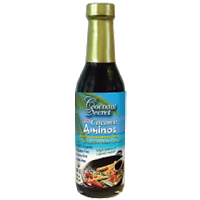 Tamari is a premium Japanese soy sauce. The major difference between Tamari and regular soy sauce is the proportion of ingredients between soybeans and wheat. While regular soy sauce contains 40-60% wheat, Organic Gluten-Free Tamari is made with 100% soybeans and no wheat. While the sodium level of Tamari and regular soy sauce is the same, the higher concentration of soybeans in Tamari gives a richer, smoother, more complex taste than ordinary soy sauce. Tamari is naturally fermented for up to 6 months and it doesn’t contain MSG or artificial preservatives. Organic Gluten-Free Tamari’s fermentation process is different than ordinary soy sauce, giving it unique flavor-enhancing properties. Add Tamari to gravies, sauces, and casseroles. Use it as a marinade and in stir-fry dishes. Reduce sodium levels in your cooking without compromising taste. One teaspoon of Organic Tamari contains one-eighth the sodium as one teaspoon of salt.
Tamari is a premium Japanese soy sauce. The major difference between Tamari and regular soy sauce is the proportion of ingredients between soybeans and wheat. While regular soy sauce contains 40-60% wheat, Organic Gluten-Free Tamari is made with 100% soybeans and no wheat. While the sodium level of Tamari and regular soy sauce is the same, the higher concentration of soybeans in Tamari gives a richer, smoother, more complex taste than ordinary soy sauce. Tamari is naturally fermented for up to 6 months and it doesn’t contain MSG or artificial preservatives. Organic Gluten-Free Tamari’s fermentation process is different than ordinary soy sauce, giving it unique flavor-enhancing properties. Add Tamari to gravies, sauces, and casseroles. Use it as a marinade and in stir-fry dishes. Reduce sodium levels in your cooking without compromising taste. One teaspoon of Organic Tamari contains one-eighth the sodium as one teaspoon of salt.
I use them in my “healthified” dressings, marinades, sauces, and rice-free sushi. Click HERE to find it.
1/2 cup organic veggie or chicken broth
1 1/2 TBS minced fresh ginger root
3 TBS organic tamari (or coconut aminos)
3 TBS natural peanut butter or sun butter
1 1/2 TBS Keto Honey (Or Swerve)
2 tsp hot chile paste (optional)
3 cloves garlic, minced
1 head of cabbage
1/4 cup chopped green onions
1/4 cup chopped peanuts or sunflower seeds
Cut cabbage into long noodle-like strips. Combine chicken broth, ginger, tamari sauce, peanut butter, Keto Honey, chili paste, and garlic in a small saucepan. Cook over medium heat until peanut butter melts and is heated through. Add cabbage “noodles”, and toss to coat. Stir fry cabbage until they are soft like noodles. Garnish with green onions and peanuts. Makes 4 servings.
NUTRITIONAL COMPARISON (per serving)
Traditional Peanut Noodles = 330 calories, 12g fat, 47 carbs, 1.9g fiber, 10.7g protein
“Healthified” Peanut Noodles = 160 calories, 12g fat, 8 carbs, 1.8g fiber, 10.1g protein






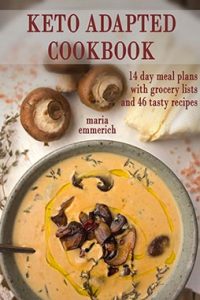

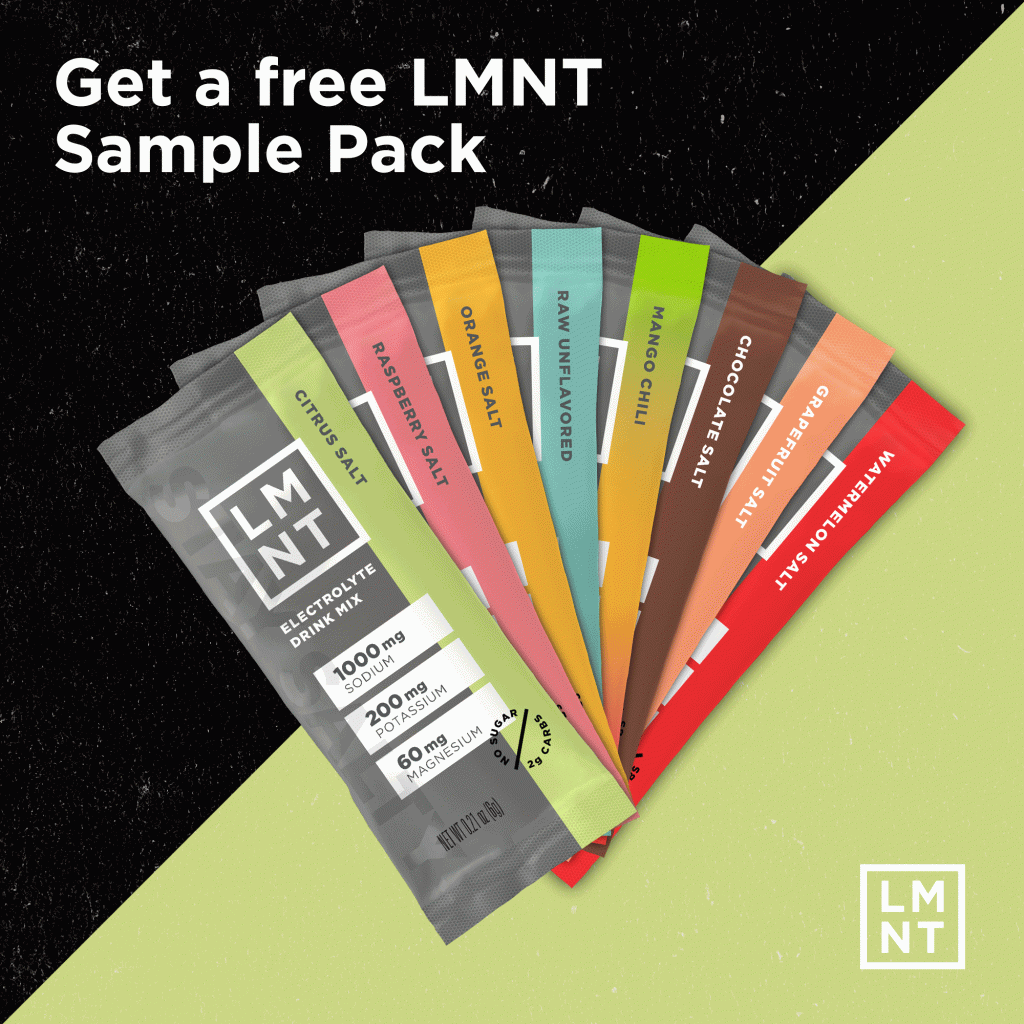


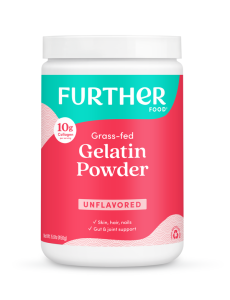

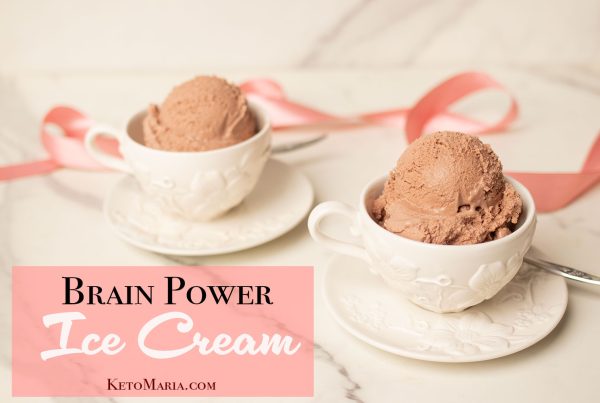


Hi Maria,
Just wanted to let you know i made this for lunch today and added in some canned tuna at the end, and it was so crazy good!! it was like a modern, asian tuna noodle casserole, just what i needed!
thank you for the recipe!
Thank you! I’m so happy you liked it!!!
Did you notice that there was a “digestive adjustment period” as you started to incorporate xylitol into your diet? I just bought a bag, but have had digestive issues before and was told to stay away from Sorbitol, Aspartame, etc…
I’ve done alot of reading on the product and they all caution about the laxative effect xylitol has, so I am a little gun shy.
Some people tolerate it better than others. It is often preferred by people who I consider “super tasters” who don’t like the taste of erythritol. BUT if you don’t mind erythritol, I would use that instead…a lot less likely to cause intestinal distress.
Maria – wanted to let you know that I’ve been using this peanut sauce on all kinds of things! I’ve been using the noodle maker from Amazon to make zucchini noodles and then putting this peanut sauce on top. My husband will actually eat vegetables with this sauce on them! He says it reminds him of Pad Thai. So excited. Thank you so very much!
Thanks for taking the time to write! I’m so happy your husband likes this too;)
Do you prefer xylitol or erythritol? Why?
I prefer erythritol because it keeps insulin lower.
ERYTHRITOL = Erythritol is a naturally-derived sugar substitute that looks and tastes very much like sugar, yet has almost no calories. Erythritol has been used in Japan since 1990 in candies, chocolate, yogurt, fillings, jellies, jams, beverages, and as a sugar substitute. Erythritol, is considered a ‘sugar alcohol’ and is found naturally in small amounts in grapes, melons, mushrooms, and fermented foods such as wine, beer, cheese, and soy sauce. Erythritol is usually made from plant sugars. Sugar is mixed with water and then fermented with a natural culture into erythritol. It is then filtered, allowed to crystallize, and then dried. The finished product is white granules or powder that resembles sugar.
CALORIES = 0 to 0.2 calories/gram (95% fewer calories than sugar)
SWEETNESS = 70% as sweet as table sugar. Use cup for cup like sugar, but you need to add a tsp of stevia glycerite to add sweetness.
WHY I USE IT = It has a crystallization property like sugar. This is why you can’t just use stevia for baking.
BENEFITS = Erythritol isn’t metabolized by oral bacteria, which means that it doesn’t contribute to tooth decay. Erythritol gets absorbed and assimilated easily in the small intestines, which reduces fermentation.
UNDESIRED PROPERTIES = It doesn’t dissolve in foods (like salad dressings/caramel)
XYLITOL= Xylitol occurs naturally in many fruits and vegetables and is even produced by the human body during normal metabolism. Manufacturers make it from plants such as birch and other hard wood trees and fibrous vegetation. Some people prefer the taste of xylitol. I only use it when I have to due to it’s higher calorie content and increases insulin a little. Before I found JUST LIKE SUGAR, I used this for my caramel sauce.
CALORIES = 2.4 calories/gram; 1 tsp has 9.6 calories and 1 tsp of sugar has 15 calories (40% fewer calories and 75% fewer carbs than table sugar)
SWEETNESS = Same as table sugar. Use cup for cup.
BENEFITS = Has been known to aid in the prevention of ear infections. Tastes more like table sugar. Dissolves in liquids and melts.
UNDESIRED PROPERTIES = Xylitol has very few known side effects, although some people report diarrhea when adding xylitol into their diets.
Glycemic Index of Sweeteners
Stevia Glycerite = 0
Erythritol = 0
Truvia/ZSWEET = 0
JUST LIKE SUGAR = 0
Xylitol = 7
Maple Syrup = 54
Honey = 62
Table Sugar = 68
High Fructose Corn Syrup = 100
This is an extremely helpful comparison. Thanks!
Wow! I’m so glad I clicked on this article, thank you for all this helpful information!
I can’t wait to try this. I’ve been looking and looking for an Asian peanut ginger sauce similar to the dressing on my salad at my favorite Japanese restaurant, that I’m sure isn’t healthy at all. The salad is really just iceberg lettuce with carrot coins, dripping in sauce. It is one of the best things in the whole world, and I usually end up licking my plate (in public, even–the horror)! Making this at home, I’ll leave out the carrot coins, but it will be so nice to be able to have this treat again! Thanks, Maria!!
This looks delicious, and I’m going to try it today. But please, whenever you talk about Xylitol, warn people that if their dog eats any of it, it will kill their dog. I personally prefer Xylitol, but it makes me too crazy worrying about something falling on the floor and my dog taking advantage of the “three second rule”.
This was soooooo good!!
I just made this and practically inhaled it, SO good!! Thanks for an awesome recipe.
Thank you! 🙂
This was too easy to make and my husband drank up the sauce. Really good! Any suggestions on what other meals we can use this quick and easy sauce for?
These noodles came out amazing!
Thanks!
I have been reading all kinds of articles about xylitol and it’s starting to scare me. I was introduced to it from your blog and have been using it quite often for baking. I understand xylitol, in its natural state, comes from plants, but it goes through a chemical process to produce the end result that we use as a sweetener (chemicals such as sulfuric acid, calcium oxide, phosphoric acid and active charcoal!) and then how it kills rats in laboratory testing. I know you don’t really use it but is it truly “healthy” to use? I thought you choose not to use it b/c it still increases insulin levels a little compared to the other sweeteners you do use. I’m giving it to my children and I’m just concerned.
I give it to my boys in moderation as well. I think it is safe in moderation. It can also kill dogs, but so can onions.